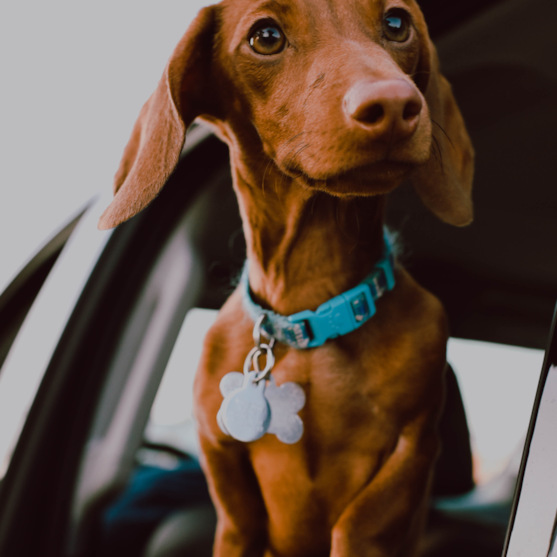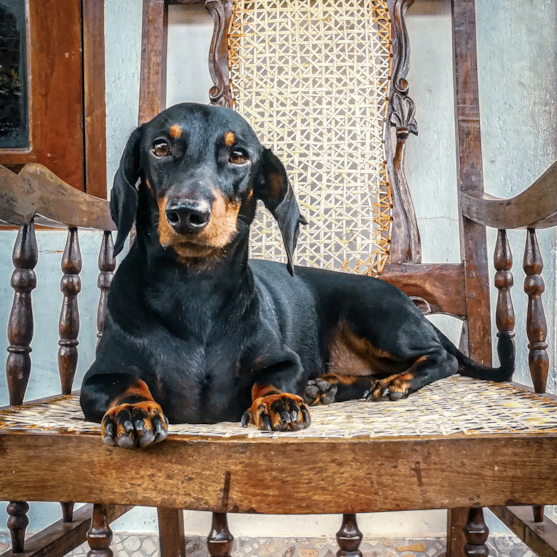Dachshund Breed Info


Discover the Dachshund: a unique and captivating breed with a rich history and unmistakable appearance. Often referred to as "wiener dogs" or "sausage dogs" due to their elongated bodies, Dachshunds were initially bred for hunting, but have since become popular companion animals. They're known for their spunky attitude, loyalty, and endearing charm. With options for different coat types and sizes, there's a Dachshund to fit every home.
Dachshunds possess an innate ability to understand and respond to their owner's emotions, making them highly empathetic pets. This intuitive nature enables them to offer comfort and support when needed, and they can often sense when their owner is upset or stressed. Dachshunds' emotional intelligence also means they respond best to gentle, positive reinforcement during training, as they can be sensitive to harsh methods.
Characteristics
- Tenacious: Dachshunds are determined and persistent, showcasing their hunting roots in their daily lives.
- Devoted: These dogs are deeply attached to their owners and will go to great lengths to please them.
- Energetic: Dachshunds have a natural zest for life, making them fun and engaging companions.
- Clever: They possess a remarkable intelligence that can be both a blessing and a challenge when it comes to training.
- Independent: Dachshunds can exhibit a strong-willed nature, often wanting to explore and investigate on their own terms.
- Warm-hearted: This breed is known for its tender and affectionate demeanor, forming close relationships with its family.
- Vigilant: Dachshunds have an acute sense of their surroundings and make excellent alert dogs, quickly notifying their owners of any unusual activity.
- Versatile: They are able to adapt to a variety of living environments, making them suitable for many different households.

Appearance
Dachshunds come in two primary sizes: standard and miniature. Standard dachshunds typically weigh between 16 and 32 pounds, while miniature dachshunds weigh 11 pounds or less. Despite the difference in size, both variations possess the characteristic long body and short legs that make the breed instantly recognizable. Dachshunds also have three coat types: smooth, wirehaired, and longhaired. The smooth coat is short and sleek, the wirehaired coat is dense and rough with a beard and eyebrows, and the longhaired coat is soft, silky, and slightly wavy.
In addition to their variety in size and coat type, dachshunds come in an array of colors and patterns. Solid colors include red and cream, while bi-color combinations typically feature black, chocolate, wild boar, or fawn paired with tan or cream markings. Dapple, brindle, and piebald patterns add further variety to the breed's appearance. The combination of size, coat type, and color options within the dachshund breed ensures there is a perfect match for every dog lover seeking a unique and endearing canine companion.
Temperament
Dachshunds are inherently social creatures who thrive on companionship. They enjoy being around people and other dogs, creating strong bonds with their families. This social nature makes them well-suited for households where they can have regular interactions with family members and other pets. Early socialization is essential to ensure that dachshunds develop positive relationships with a wide range of people and animals.
The dachshund's persistence and determination are vital aspects of their character. Originally bred for hunting, these traits enabled them to persevere in their pursuit of prey. Nowadays, this persistence can be channeled into various activities, such as scent work, tracking, or obedience training. It also means that dachshunds may need patient and consistent guidance during training sessions to overcome any stubborn tendencies.
Care
Grooming
Dachshunds are known for their unique and charming appearance, which makes them a popular choice among dog lovers. Just like any other dog breed, dachshunds require regular grooming to keep them looking their best and maintain their overall health.
- Brushing: Dachshunds have three different coat types: smooth, longhaired, and wirehaired. Each coat type requires a different brushing routine. For smooth-coated dachshunds, a weekly brushing with a soft-bristle brush or rubber grooming mitt is sufficient to remove loose hair and debris. Longhaired dachshunds need to be brushed two to three times a week with a pin brush or slicker brush to prevent matting and tangles. Lastly, wirehaired dachshunds should be brushed weekly with a slicker brush and require hand stripping every few months to maintain their coat's texture.
- Bathing: It is essential to bathe your dachshund every four to six weeks to keep their coat clean and free of dirt. Use a mild dog shampoo, being cautious to avoid getting water in their ears or eyes. Always thoroughly rinse the shampoo from their coat to avoid skin irritation. For wirehaired dachshunds, it's best to bathe them before hand stripping to facilitate the process.
- Ear Care: Dachshunds have long, floppy ears that are prone to infections and parasites. To keep their ears healthy, check and clean them weekly using a soft, damp cloth or cotton ball with an ear cleaning solution made for dogs. Be sure to never insert anything into their ear canal, and consult a vet if you notice any redness, swelling, or foul smell.
- Nail Trimming: Regular nail trimming is crucial for dachshunds, as overgrown nails can lead to discomfort and even joint problems. Trim your dachshund's nails every three to four weeks using dog nail clippers or a grinder. If you're unsure about the process, consult a professional groomer or veterinarian for guidance.
Exercise Needs
Dachshunds were originally bred as hunting dogs, which means they have a natural stamina and endurance that necessitates daily exercise. Aiming for at least 30 minutes of physical activity per day helps keep your Dachshund in good shape, burn off excess energy, and avoid boredom. These exercise sessions can be divided into shorter periods if needed.
Regular walks at a moderate pace are a perfect way to keep your Dachshund active while allowing them to explore and socialize with other dogs. It's crucial to keep your dog on a leash during walks to ensure their safety and prevent them from chasing small animals.
Interactive playtime is another great way to provide exercise for your Dachshund. They enjoy engaging in games such as fetch or hide-and-seek, which not only offer physical exercise but also mental stimulation. However, it's important to be mindful of their elongated spine and avoid activities that involve excessive jumping or sudden twists.
Indoor activities can be a valuable addition to your Dachshund's exercise routine, especially on days when outdoor activities are not feasible. Puzzle toys, treat-dispensing toys, or gentle tug-of-war games can keep your dog entertained and mentally stimulated while indoors.
It is essential to take precautions when exercising your Dachshund, as their unique body structure makes them prone to spinal issues, such as intervertebral disc disease (IVDD). High-impact activities and excessive stair climbing should be avoided to minimize the risk of injury. Always monitor your Dachshund for any signs of discomfort or pain during exercise.
Health
Dachshunds are an adorable breed, but they are not immune to health concerns. As a responsible owner, it's important to be aware of potential health issues that may arise in your Dachshund. Here are a few things to keep in mind:
One common issue in Dachshunds is their predisposition to obesity. Their low-slung body type, coupled with their love for food, can make them particularly susceptible to weight gain. To combat this, a healthy diet and regular exercise routine should be maintained to keep them at a healthy weight. Another area of concern is their dental health. Small breeds like Dachshunds may be prone to dental issues, such as tooth decay and gum disease. Regular teeth brushing and dental check-ups with your veterinarian can help prevent these issues and ensure your dog maintains a healthy mouth.
As Dachshunds age, they may also be at risk for eye problems such as cataracts. Monitoring their vision and regularly taking them to the veterinarian can help detect and manage these issues early on.
By staying informed and addressing any potential health concerns proactively, you can help ensure your Dachshund remains happy, healthy, and active for years to come.
Lifespan
Dachshunds have a lot of love to offer, and fortunately, they can live a long and fulfilling life with their owners. They typically enjoy a lifespan of 12-16 years, but with proper care, that lifespan can be extended even further. By providing them with a nutritious diet, regular exercise, and consistent veterinary care, you can help ensure that they remain healthy and happy throughout their lives. Dachshunds are beloved for their playful personalities, and with the right care, they can continue to bring joy to their owners for many years to come.
Training
Training a Dachshund can be a rewarding but challenging experience, especially given their stubborn nature. However, starting training during early puppyhood can help you get the best results and create a happy and well-behaved companion.
During early puppyhood, Dachshunds are like sponges, soaking up everything they see and experience. This makes it the ideal time to begin socialization and basic obedience training. By exposing your puppy to different people, animals, and environments, you can help them become well-adjusted and confident.
Starting obedience training early is also essential. Teaching your Dachshund basic commands such as "sit," "stay," and "come" can help establish good habits and reinforce positive behavior. This can also make it easier to manage any behavioral problems that may arise later on.
Consistency and positive reinforcement are also key when training a Dachshund. Providing praise, treats, and other rewards for good behavior can help encourage them to repeat that behavior. Being consistent with rules and boundaries can also help establish expectations and ensure your Dachshund understands what is expected of them.
History
The fascinating history of the Dachshund dates back to the 15th century in Germany, where they were primarily bred for hunting purposes. Their name, "Dachshund," is derived from the German words for badger ("Dachs") and dog ("Hund"), reflecting their original role as badger hunters. Their elongated bodies and short legs allowed them to efficiently navigate narrow tunnels to pursue their prey.
Over the centuries, the breed diversified as hunters sought to refine their skills in various terrains and climates. This led to the development of the wirehaired and longhaired coat types, as well as the miniature size. The wirehaired variety was created to better handle harsh, thorny underbrush, while the longhaired Dachshund was bred for colder environments, providing extra warmth and protection.
In the 19th century, Dachshunds began to make their way into the hearts and homes of people beyond Germany. They were first imported to the United States in the late 1800s, and the breed's popularity quickly spread. By the early 20th century, Dachshunds had become a beloved breed worldwide, known for their distinctive appearance, intelligence, and spirited nature.
Today, Dachshunds remain a popular choice for dog lovers, both as companion animals and as participants in various dog sports, such as earthdog trials and agility competitions. Their rich history and unique charm continue to make them a favorite among canine enthusiasts.
